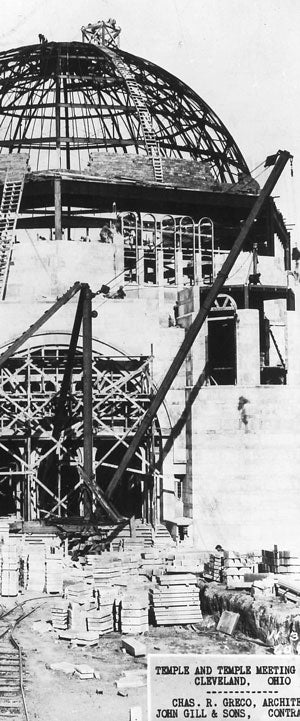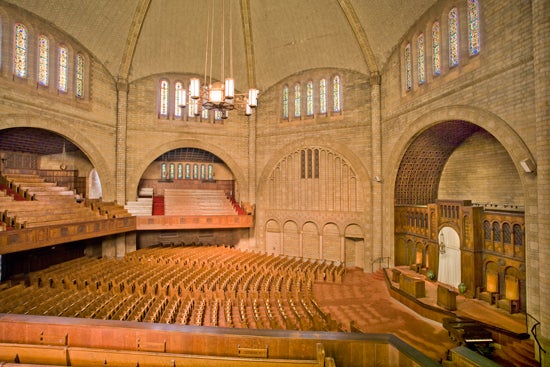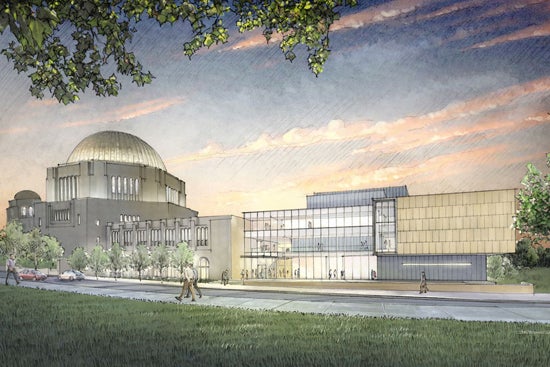Would you like a tour of the building with historical insight from a knowledgeable tour guide? Book your tour today!
A Historic Past
For 90 years, The Temple – Tifereth Israel has been the home of one of the nation’s largest and most dynamic Reform Jewish congregations. Even when most of its daily activities and religious services shifted to the congregation’s branch in Beachwood in the 1970s, the grand building on Ansel Road continued to be its heart.
Tifereth Israel (Glory of God) was founded in 1850 with 47 families and grew rapidly. By 1917 the congregation, with more than 700 families, was one of the largest in the world and had outgrown its facility at East 55th and Central Avenue. Congregational leaders engaged architect Charles Greco of Boston to design their new home and in 1922, ground was broken for the new temple at Ansel Road and 105th Street. When it was completed in 1924, Henry Turner Bailey, the director of the Cleveland School of Art (now the Cleveland Institute of Art), described the Byzantine-style building as “one of the masterpieces of the city.”
The building’s heptagonal shape was arrived at because it closely approximates a circle, which lends itself best to the seating of a congregation, and expresses the idea of the unity of God, one of the fundamentals of the Jewish faith. It also fits the oddly shaped lot perfectly, presenting a side parallel to each street. The Temple’s large gold dome is a landmark in the Upper Chester and University Circle neighborhoods, and it caps a lofty interior of awe-inspiring beauty. In 1974 the building was listed on the National Register of Historic Places.
In addition to its distinctive architecture, the Temple is renowned for the extraordinarily distinguished rabbis who have occupied its pulpit, particularly Rabbi Abba Hillel Silver and his son, Rabbi Daniel Silver, whose combined tenure lasted 72 years, and who to a great extent defined the identity of Tifereth Israel.
With his powerful intellect and his imposing bearing (described as that of an Old Testament prophet), Abba Hillel Silver was a riveting presence on the pulpit. He was known for his Sunday-morning lectures, which reflected a combination of scholarship and spirituality, and which were widely attended not only by the congregation, but also by non-Jewish members of the community. As an internationally recognized leader of the Zionist movement, Abba Hillel Silver spoke to audiences in the U.S. and abroad advocating the establishment of a Jewish homeland in Palestine. His famous address to the United Nations in 1947 contributed to the creation of the state of Israel.
In 1963, upon Abba Hillel Silver’s death, Rabbi Daniel Silver assumed the leadership of the congregation. A scholar and great intellect like his father, “Rabbi Dan,” as he was affectionately known, was a devoted and inspiring spiritual leader. Concerned about the emerging challenges in the neighborhood, he was determined that the Temple remain vital to the inner city, and chaired several civic groups committed to the welfare of the community.
At his untimely death in 1989, Rabbi Daniel Silver left behind a grieving congregation, but one that over the course of two generations had been immeasurably enriched by his leadership and that of his father; and a legacy that continues to be felt from Cleveland to Tel Aviv.
A Magnificent Present
One of only a few projects of its kind in the country, the Maltz Performing Arts Center was created through a historic partnership between Case Western Reserve University and The Temple – Tifereth Israel. The extraordinary generosity and vision of Milton and Tamar Maltz, together with like-minded philanthropic leaders, has resulted in this extraordinary, unprecedented project on the university’s campus.
With the completion of Phase One, the Milton and Tamar Maltz Performing Arts Center at The Temple – Tifereth Israel has become a place for a diverse selection of music, lectures and a variety of cultural enrichment opportunities.
Historic Silver Hall, with seating for 1,200 people, showcases students from Case Western Reserve’s music department, whose 19 ensembles include a symphony orchestra; an Early Music vocal ensemble; Baroque chamber ensembles and orchestra; ensembles for jazz, wind, and popular music; and the Case Concert Choir.
In 2018, the very unique Silver Hall Concert Series was launched to showcase ensembles from across northeast Ohio, providing them with the valuable opportunity to perform a recorded concert in a large venue. The concert series attracted 15,000 guests during the 2019-2020 season alone. LIVE! from Silver Hall was established in August 2020 in partnership with the Ohio Arts Professionals Network to livestream local and regional acts from folk bands to classical quartets to rock bands.
While Silver Hall is used by The Temple – Tifereth Israel congregation for religious observances and occasional life-cycle events, Case Western Reserve has made The Maltz Performing Arts Center a destination for the Cleveland community to enjoy classical, jazz and gospel music concerts by local and national performers as well as the exchange of thought-provoking ideas. It is home to both Think Forum, Case Western Reserve's distinguished lecture series, and Cuyahoga County Public Library's William M. Skirball Writers Center Stage.
The Nord Family Greenway connects the Maltz Performing Arts Center to the rest of campus and the surrounding University Circle neighborhoods. The greenway is a beautiful 20-acre ribbon of lawn, with pathways and trees extending west from Case Western Reserve's Tinkham Veale University Center, across the Fine Arts Garden at the Cleveland Museum of Art, and,continuing to East 105th Street and the Maltz Performing Arts Center's front door.
Lifting the Curtain on a Bright Future
“This is a dream come true,” remarked Case Western Reserve University former President Barbara R. Snyder in October 2019, as she and members of the university community broke ground on Phase Two of The Milton and Tamar Maltz Performing Arts Center. With completion scheduled for mid-2021, Phase Two will bring even more transformative changes to Case Western Reserve students, University Circle and Greater Cleveland.
Phase Two will provide the new state-of-the-art home to the Case Western Reserve’s Department of Theater, including the department chair’s office and administrative offices for both undergraduate and graduate studies, as well as the university’s nationally renowned Masters in Fine Arts Acting Program, an important partnership with Cleveland Play House.
Further Phase Two additions include:
Black Box theater with 150 moveable seats;
Roe Green Proscenium theater with seating for 250;
Grand Atrium and foyer (2,000 square feet) with a cafe and coat check common-gathering area serving all three theaters; and
Rehearsal studios, practice rooms, costume and scene shops.
The impact of completing Phase Two of the Maltz Performing Arts Center will be most profound in three areas: It will 1) provide technological resources that open new possibilities for education, performance and outreach, 2) provide the performing arts departments with fully functional teaching, rehearsal and performance spaces for the first time in the university’s history, and 3) raise the visibility of performing arts on campus and enhance the university’s reputation for fostering creativity and collaboration in every domain.




